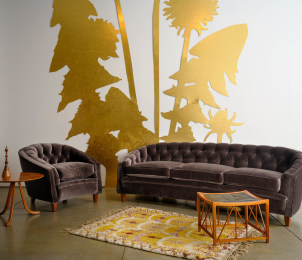
CARL MALMSTEN (Swedish, 1888–1972)
Vanity for Bodafors, Sweden, ca. 1964
Oak
47.5" H x 34" W x 20" D
Carl Malmsten was Sweden's leading furniture designer in the mid-twentieth century. He was also an architect and educator, responsible for founding several trade schools specializing in craft and design that were crucial to advancing the Swedish arts. Malmsten's oeuvre, which encompasses a broad spectrum of forms in styles ranging from simple pine construction to Gustavian Rococo, is defined by an overarching commitment to the preservation of the unmatched quality of traditional Swedish craftsmanship.
Malmsten was a prolific craftsman; there are 10,000 different models of furniture attributed to Malmsten worldwide, as well as 20,000 drawings and detailed models. Malmsten's furniture was and still is featured prominently within important interiors throughout Sweden. As early as 1916, several of Malmsten's very first designs were installed at the Stockholm City Hall, and in the 1920s, he was invited to furnish a room for the crown prince Gustaf VI Adolf in the Ulriksdal Palace. Additionally, Malmsten designed pieces for the Stockholm Concert Hall in 1928 and The Tändstickspalatset (Matchstick Palace) in the 1940s. Malmsten's works were popularized through a multitude of exhibitions, which include Hemutställningen Liljevalchs in 1917 where his works were shown alongside those of well-known Swedish architects Gunnar Asplund and Uno Åhrén. He also exhibited in Gothenburg in 1923, at the World Exhibition in Paris in 1925, in New York in 1927, at Liljevalch again in 1928, and in Stockholm in 1930.
The Stockholm Exhibition of 1930 in which Malmsten participated, however, was a definitive moment in the trajectory of his designs as representative of the high standards of Swedish handicraft and artisanship. Organized by the Swedish Society of Craft and Industrial Design, the exhibition served to showcase industrial designs by craftsmen and architects that could be both practical and cost-effective for working-class families. While works by Malmsten were featured, he maintained that the majority of works on display were repetitive, lacking in character, and unrepresentative of Swedish culture and tradition.
Malmsten remained a vocal opponent of functionalism, instead advocating for creative manual work that could be at once accessible, high quality, and suited to individual tastes. He conceived of wide-ranging styles inspired by Swedish nature and culture as well as modern forms, and his furniture lines were named after clients, places, and moods with which he associated each piece's production. With each work, whether it was an elaborate and inlaid bourgeois creation using exotic woods or a simplistic birch or pine piece in the "peasant" style, Malmsten ensured that his furniture was durable, functional, and executed to the highest technical specifications. Malmsten opened his first store in Norrmalmstrong in 1930, as well as Carl Malmsten Furniture Studies, a workshop school in Stockholm, with the objective of reforming the production of handicrafts. He established the famed Malmstenbutiken in the 1940s, where he contributed designs until his death in 1972, and also designed for companies like Bodafors and Atvidaberg.
In 1955 Malmsten established a network of Key Workshops (Nyckelverkstäderna), which consisted of ten outstanding Swedish furniture manufacturers that Malmsten personally selected to serially produce his signature furniture. The first model by the Key Workshops was presented in 1956 at an exhibition at the Röhsska Museum in Gothenburg. Through this widespread production, Malmsten was able to increase the availability and affordability of his furniture, while maintaining high standards for craftsmanship. Profits from the Key Workshop series production enabled the founding of Capellagården, the Carl Malmsten School for Creative Work in Öland, which has presently trained more than 100 craftsmen in the fields of textile craft and design, cabinet making, furniture design, interior carpentry, ceramics, and organic horticulture. Malmsten has ensured a legacy of functional, individualized, high-quality handicrafts through his own practice, his multitude of workshops, and educational institutions. His emphasis on precise technical execution united with an entrepreneurial spirit has perpetuated an appreciation for his wonderful and varied forms throughout Sweden and internationally.